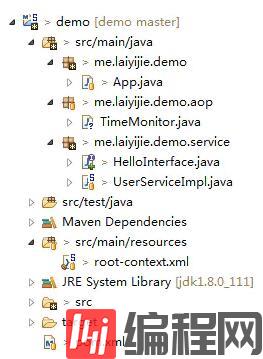这期内容当中小编将会给大家带来有关@Around注解怎么在spring aop中使用,文章内容丰富且以专业的角度为大家分析和叙述,阅读完这篇文章希望大家可以有所收获。@Around注解可以用来在调用一个具体方法前和调用后来完成一些具体的任务
这期内容当中小编将会给大家带来有关@Around注解怎么在spring aop中使用,文章内容丰富且以专业的角度为大家分析和叙述,阅读完这篇文章希望大家可以有所收获。
@Around注解可以用来在调用一个具体方法前和调用后来完成一些具体的任务。
比如我们想在执行controller中方法前打印出请求参数,并在方法执行结束后来打印出响应值,这个时候,我们就可以借助于@Around注解来实现;
再比如我们想在执行方法时动态修改参数值等
类似功能的注解还有@Before等等,用到了Spring AOP切面思想,Spring AOP常用于拦截器、事务、日志、权限验证等方面。
需要说明的是,在以下例子中,我们即可以只用@Around注解,并设置条件,见方法run1();也可以用@Pointcut和@Around联合注解,见方法pointCut2()和run2(),这2种用法是等价的。如果我们还想利用其进行参数的修改,则调用时必须用joinPoint.proceed(Object[] args)方法,将修改后的参数进行回传。如果用joinPoint.proceed()方法,则修改后的参数并不会真正被使用。
import org.aspectj.lang.ProceedingJoinPoint;import org.aspectj.lang.annotation.Around;import org.aspectj.lang.annotation.Aspect;import org.aspectj.lang.annotation.Pointcut;import org.aspectj.lang.reflect.MethodSignature;import org.slf4j.Logger;import org.slf4j.LoggerFactory;import org.springframework.beans.factory.annotation.Autowired;import org.springframework.stereotype.Component; import javax.persistence.EntityManager; @Component@Aspectpublic class ControllerAspect { private static final Logger logger = LoggerFactory.getLogger(ControllerAspect.class); @Autowired private EntityManager entityManager; @Around("execution(* com.company.controller.*.*(..))") public Object run1(ProceedingJoinPoint joinPoint) throws Throwable { //获取方法参数值数组 Object[] args = joinPoint.getArgs(); //得到其方法签名 MethodSignature methodSignature = (MethodSignature) joinPoint.getSignature(); //获取方法参数类型数组 Class[] paramTypeArray = methodSignature.getParameterTypes(); if (EntityManager.class.isAssignableFrom(paramTypeArray[paramTypeArray.length - 1])) { //如果方法的参数列表最后一个参数是entityManager类型,则给其赋值 args[args.length - 1] = entityManager; } logger.info("请求参数为{}",args); //动态修改其参数 //注意,如果调用joinPoint.proceed()方法,则修改的参数值不会生效,必须调用joinPoint.proceed(Object[] args) Object result = joinPoint.proceed(args); logger.info("响应结果为{}",result); //如果这里不返回result,则目标对象实际返回值会被置为null return result; } @Pointcut("execution(* com.company.controller.*.*(..))") public void pointCut2() {} @Around("pointCut2()") public Object run2(ProceedingJoinPoint joinPoint) throws Throwable { //获取方法参数值数组 Object[] args = joinPoint.getArgs(); //得到其方法签名 MethodSignature methodSignature = (MethodSignature) joinPoint.getSignature(); //获取方法参数类型数组 Class[] paramTypeArray = methodSignature.getParameterTypes(); if (EntityManager.class.isAssignableFrom(paramTypeArray[paramTypeArray.length - 1])) { //如果方法的参数列表最后一个参数是entityManager类型,则给其赋值 args[args.length - 1] = entityManager; } logger.info("请求参数为{}",args); //动态修改其参数 //注意,如果调用joinPoint.proceed()方法,则修改的参数值不会生效,必须调用joinPoint.proceed(Object[] args) Object result = joinPoint.proceed(args); logger.info("响应结果为{}",result); //如果这里不返回result,则目标对象实际返回值会被置为null return result; }}补充:Spring Aop实例(AOP 如此简单)@Aspect、@Around 注解方式配置
ioc相关的基本内容告一段落,本次介绍Spring的第二个特性,AOP,面向切面编程,术语听起来比较不容易理解,没关系,一切尽在实例中,让我们看一个简单的实例,就能明白。
项目工程目录结构和代码获取地址
获取地址(版本Log将会注明每一个版本对应的课程)
https://GitHub.com/laiyijie/SpringLearning

运行具有Main函数的 App.java
得到如下输出
method start time:1480223298250userHellomethod end time:1480223299250从App.java入手
App.java
package me.laiyijie.demo;import org.springframework.context.support.ClassPathXmlApplicationContext;import me.laiyijie.demo.service.HelloInterface;public class App { public static void main(String[] args) { ClassPathXmlApplicationContext context = new ClassPathXmlApplicationContext("root-context.xml"); HelloInterface userService = context.getBean(HelloInterface.class); userService.sayHello(); context.close(); }}调用的是HelloInterface的sayHello方法
HelloInterface.java
package me.laiyijie.demo.service;public interface HelloInterface{ void sayHello(); }其实现类为UserServiceImpl.java
UserServiceImpl.java
package me.laiyijie.demo.service;import org.springframework.stereotype.Service;@Servicepublic class UserServiceImpl implements HelloInterface { public void sayHello() { try { Thread.sleep(1000); } catch (InterruptedException e) { // TODO Auto-generated catch block e.printStackTrace(); } System.out.println("userHello"); } }诶?情况跟我们看到的代码有出入?
sayHello 应该只输出 userHello,前后两行输出从何出现?
在Main函数中找不到一点儿线索!
这就是AOP的一个强大特性:
无侵入性,不改变原有的代码,却能增加功能!
那么究竟是如何增加功能的呢?
让我们看看TimeMonitor.java
TimeMonitor.java
package me.laiyijie.demo.aop;import org.aspectj.lang.ProceedingJoinPoint;import org.aspectj.lang.annotation.Around;import org.aspectj.lang.annotation.Aspect;import org.springframework.stereotype.Service;@Service@Aspectpublic class TimeMonitor { @Around("execution(* me.laiyijie.demo.service.UserServiceImpl.sayHello(..))") public void monitorAround(ProceedingJoinPoint pjp) throws Throwable { System.out.println("method start time:" + System.currentTimeMillis()); Object re = pjp.proceed(); System.out.println("method end time:" + System.currentTimeMillis()); }}终于看到了 method start time:1480223298250 和 method end time:1480223299250这两行输出是从哪儿出现的了!
让我们来仔细解读一下这个类
类有两个注释,分别是@Service和@Aspect,第一个注解是使得TimeMonitor受Spring托管并实例化。@Aspect就是使得这个类具有AOP功能(你可以这样理解)两个注解缺一不可
类里面只有一个方法,名字叫做monitorAroud,其实就是为了检测函数执行时间的!
那么关键点来了,两个输出语句是怎么插入到sayHello方法的前后的呢!
看这个注解:
@Around("execution(* me.laiyijie.demo.service.UserServiceImpl.sayHello(..))")@Around表示包围一个函数,也就是可以在函数执行前做一些事情,也可以在函数执行后做一些事情
execution(* me.laiyijie.demo.service.UserServiceImpl.sayHello(..))这个比较好理解,就是使用表达式的方式指定了要对哪个函数进行包围!(除了execution以外还有很多,可以搜索AspectJ语法来学习)
也就是说,这个注解完整的说明了,应该在函数的什么位置插入变化,也就是所谓的切点
之后是函数的定义:
public Object monitorAround(ProceedingJoinPoint pjp)这里引入了ProceedingJoinPoint,在使用了@Around之后可以带入这个参数,代表的其实就是sayHello这个函数,不过做了一些封装
而 Object re = pjp.proceed(); 就是相当于执行了 sayHello方法!
剩下的代码就不用过多解释了,就是在执行这个函数的前后分别进行了系统时间的获取。
我们把这个函数体,也就是定义了要做那些事情的代码,称作增强
而包含切点和增强结合起来就称作切面
面向切面由此而来!
需要配置两项
pom.xml增加依赖(因为要用到AOP还需要不同的jar包)
root-context.xml中增加切面相关配置
root-context.xml
<?xml version="1.0" encoding="UTF-8"?><beans xmlns="Http://www.springframework.org/schema/beans" xmlns:xsi="http://www.w3.org/2001/XMLSchema-instance" xmlns:context="http://www.springframework.org/schema/context" xmlns:aop="http://www.springframework.org/schema/aop" xsi:schemaLocation="http://www.springframework.org/schema/beans http://www.springframework.org/schema/beans/spring-beans.xsd http://www.springframework.org/schema/context http://www.springframework.org/schema/context/spring-context-4.3.xsd http://www.springframework.org/schema/aop http://www.springframework.org/schema/aop/spring-aop-4.3.xsd"> <aop:aspectj-autoproxy></aop:aspectj-autoproxy> <context:component-scan base-package="me.laiyijie.demo"></context:component-scan></beans>root-context.xml 增加了两行
xmlns:aop="http://www.springframework.org/schema/aop"
代表加入命名空间
<aop:aspectj-autoproxy></aop:aspectj-autoproxy>
使用1中引入的aop命名空间开起自动代理(自动代理具体含义后续慢慢解释,简单的理解就是AOP的实现是依靠自动代理实现的)
pom.xml
<project xmlns="http://Maven.apache.org/POM/4.0.0" xmlns:xsi="http://www.w3.org/2001/XMLSchema-instance" xsi:schemaLocation="http://maven.apache.org/POM/4.0.0 http://maven.apache.org/xsd/maven-4.0.0.xsd"> <modelVersion>4.0.0</modelVersion> <groupId>me.laiyijie</groupId> <artifactId>demo</artifactId> <version>0.0.1-SNAPSHOT</version> <packaging>jar</packaging> <dependencies> <!-- https://mvnrepository.com/artifact/org.springframework/spring-context --> <dependency> <groupId>org.springframework</groupId> <artifactId>spring-context</artifactId> <version>4.3.2.RELEASE</version> </dependency> <!-- https://mvnrepository.com/artifact/org.aspectj/aspectjweaver --> <dependency> <groupId>org.aspectj</groupId> <artifactId>aspectjweaver</artifactId> <version>1.8.9</version> </dependency> </dependencies></project>增加了一个依赖
AspectJ 一个强大的AOP框架,也就是@Aspect和@Around以及ProceedingJoinPoint这些注解和方法的提供者
上述就是小编为大家分享的@Around注解怎么在Spring AOP中使用了,如果刚好有类似的疑惑,不妨参照上述分析进行理解。如果想知道更多相关知识,欢迎关注编程网精选频道。
--结束END--
本文标题: @Around注解怎么在Spring AOP中使用
本文链接: https://www.lsjlt.com/news/246387.html(转载时请注明来源链接)
有问题或投稿请发送至: 邮箱/279061341@qq.com QQ/279061341
下载Word文档到电脑,方便收藏和打印~
2024-05-15
2024-05-15
2024-05-15
2024-05-15
2024-05-15
2024-05-15
2024-05-15
2024-05-15
2024-05-15
2024-05-15
回答
回答
回答
回答
回答
回答
回答
回答
回答
回答
0